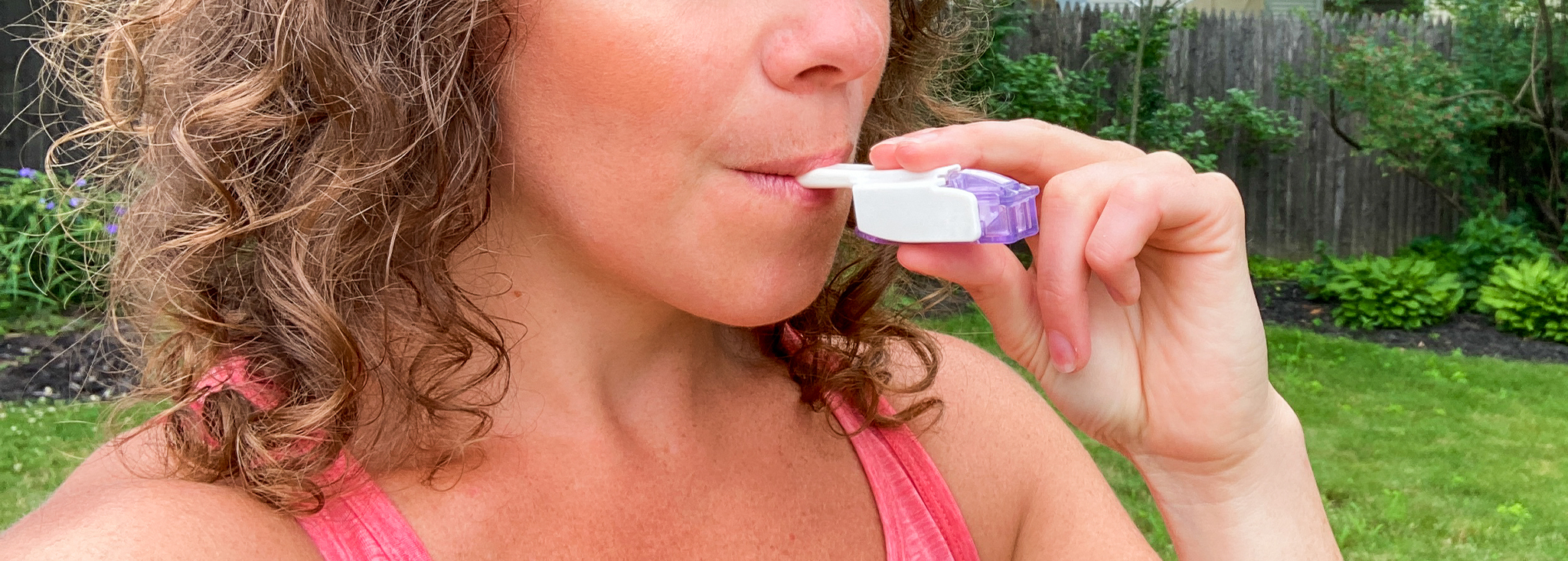How Inhaled Insulin Helped Me Recover From Diabulimia
Written by: Ginger Vieira
5 minute read
June 15, 2022
Editor’s Note: This article is about Cynthia Celt’s personal experience using Afrezza, and what has worked for her may not work for everyone. Please consult your healthcare team before making any changes to your diabetes care regimen. Beyond Type 1 has an active partnership with MannKind, makers of Afrezza. This article was not published as part of that partnership, and the company had no input in its creation. Cynthia Celt also worked for MannKind for several years in the role of “patient advocate,” sharing her story of diabulimia recovery.
Cynthia Celt struggled with diabulimia—a life-threatening eating disorder—for nearly 20 years before she started using inhaled insulin.
“I would literally look at that vial of injectable rapid-acting insulin and have anxiety over eating disordered thoughts,” says Celt, who was diagnosed with type 1 diabetes at age 19.
Today, at 43 years old, she’s successfully managed an A1c in the high 5s with Afrezza (inhaled insulin), Tresiba (long-acting basal insulin) and a Dexcom continuous glucose monitor (CGM) while maintaining her recovery from diabulimia.
“My A1c dropped from 14% to 6.3% in eight weeks.”
By the time Celt tried Afrezza, her struggle with diabulimia brought her A1c up to 14%, an average blood sugar of 19.7 mmol/L355 mg/dL.
“The first time I took Afrezza, my blood sugar came down so fast, I felt like, for the first time, I was in charge of my diabetes and not the other way around,” recalls Celt.
“That was the first time I’d seen 5.5 mmol/L100 mg/dL on my blood glucose meter in so long. Once I saw how much easier it was to keep my blood sugar in the 100s with Afrezza, I wanted to keep taking it. Success breeds success. I felt so much better, so quickly. The brain fog and depression from years of chronic high blood sugars vanished, and I felt really good. Good enough to keep going and keep trying. Afrezza gave me the positive diabetes feedback I had been searching for my entire diabetes life.”
As someone who used to eat a strict low-carb diet, Celt says Afrezza’s fast-action also helps her eat a vegetarian diet that is slightly higher in carbohydrates.
“It makes me feel more confident eating higher-carb foods because I don’t have to necessarily pre-bolus to prevent that post-meal spike,” explains Celt. “And even if I underestimate my dose, I can get my blood sugar back in range very quickly.”
After a decade of trying unsuccessfully to have a baby, using Afrezza along with a Dexcom and Tresiba gave Celt the confidence, tools and health she needed to pursue a healthy pregnancy. Her daughter is 4 years old today and the light of Celt’s life!
“Using inhaled insulin during pregnancy worked really well for me,” shares Celt. “My AIC, time-in-range and stable blood sugars during delivery are one of my proudest life accomplishments to date!”
While inhaled has not been studied or approved for use during pregnancy, Celt’s healthcare team supported her use of it considering her success with it prior to pregnancy and its effect on her recovery from diabulimia.
“Inhaled insulin doesn’t trigger my eating disorder.”
Within weeks of using inhaled insulin, Celt realized that the usual triggers for eating disorder behavior in diabetes management were no longer an issue.
“Afrezza is a totally different experience that doesn’t trigger my eating disorder,” explains Celt, who also credits support from We Are Diabetes in her recovery.
For those in recovery from diabulimia, managing and resisting the thoughts that can lead to withholding insulin is a daily effort. For Celt, inhaled insulin actually addressed several of those daily potential triggers.
Celt says some of the things that can usually trigger her own eating disorder thoughts in day-to-day diabetes management include:
- High blood sugars: The feeling of an accidental high blood sugar triggers wanting to let it go higher with purposeful insulin omission.
- How Afrezza helped her manage this: “Preventing and correcting high blood sugars is so fast with Afrezza that it gets me out of that high zone and away from those eating disorder thoughts so quickly.”
- Low blood sugars: The urge to binge-eat with low blood sugars can then trigger feelings of guilt, fear of weight gain and then reactive insulin omission.
- How Afrezza helped her manage this: “The lows with Afrezza are so much easier to manage because it’s often out of your system within 90 minutes, and the last 30 of those minutes is just a minimal tail. With injected insulin, I never knew how low I would go and for how long I would be low because it’s in your system for four hours after injecting. The fear, anxiety and food cravings…that doesn’t happen for me with Afrezza.”
- Dosing insulin: For Celt, the task of determining a dose for every meal left a lot of opportunity to under-bolus, limiting insulin and letting her blood sugars run high.
- How Afrezza helped her manage this: “There are only three dosing options with Afrezza: 4, 8 and 12 units. The simplicity of that makes it so much easier to just take my insulin and move on. It’s a totally different way of managing insulin dosing—Afrezza ‘units’ are different than injected insulin units. Afrezza is more of a small, medium and large mindset for meals and dosing.”
The only thing still lacking in inhaled insulin for Celt is a smaller dosing option. Like many, she hopes for 1 or 2-unit cartridges for those with a higher sensitivity to insulin, correcting mildly high blood sugar levels, and for eating low-carb meals.
“It makes dosing insulin with gastroparesis so much easier.”
While Celt has reclaimed her life after 20 years of diabulimia, two decades of blood sugar levels above 16.6 mmol/L300 mg/dL left their mark. Celt says her years of diabulimia led to the development of:
- Gastroparesis: damage to the vagus nerve in your digestive tract
- Retinopathy: damage to the blood vessels in your eyes
- Neuropathy: damage to the nerves in your feet, toes, fingers and hands
For a person with type 1 diabetes and gastroparesis, it can be very difficult to match injected rapid-acting insulin with the unpredictable timing of when your meal will actually start to digest.
“I have such severe gastroparesis,” explains Celt. “I have no idea when my stomach is going to finally dump the glucose from my digested meal into my bloodstream and when my meal is going to actually start raising my blood sugar. It can be so frustrating when I’m working so hard to manage better blood sugars.”
Since Afrezza’s action is very fast, Celt can dose the moment she sees her blood sugar rising and prevent post-meal spikes. The ability to do this also hugely prevents low blood sugars from taking her insulin too early.
Fortunately, since her recovery from diabulimia began—and she worked to improve her A1c and time-in-range—Celt says both her retinopathy and her neuropathy have improved.
“My eyes have completely recovered,” says Celt proudly. “I have no visible signs of retinopathy anymore, and I really credit a lot of that to using Afrezza to help bring my blood sugars back into a healthy range.”
“Inhaled insulin restored my life.”
After six and a half years in recovery, Celt knows her future is bright, and her battle with diabulimia is well in her past.
“Inhaled insulin restored my life,” says Celt “It was my saving grace when nothing else helped. My biggest wish is for anyone living with diabetes to find the tool that allows them to live their best life with diabetes.”

Author
Ginger Vieira
Ginger Vieira is an author and writer living with type 1 diabetes, celiac disease, fibromyalgia and hypothyroidism. She’s authored a variety of books, including “When I Go Low” (for kids), “Pregnancy with Type 1 Diabetes,” and “Dealing with Diabetes Burnout.” Before joining Beyond Type 1, Ginger spent the last 15 years writing for Diabetes Mine, Healthline, T1D Exchange, Diabetes Strong and more! In her free time, she is jumping rope, scootering with her daughters, or walking with her handsome fella and their dog.
Related Resources

Editor’s Note: Educational content related to inhaled insulin is made possible with support from MannKind,...
Read more

Sensitive Topic Warning: This article discusses disordered eating, including purging, severe calorie restriction and insulin...
Read more

Editor’s Note: This content was originally published at OnTrack Diabetes, acquired by EndocrineWeb, and is...
Read more

